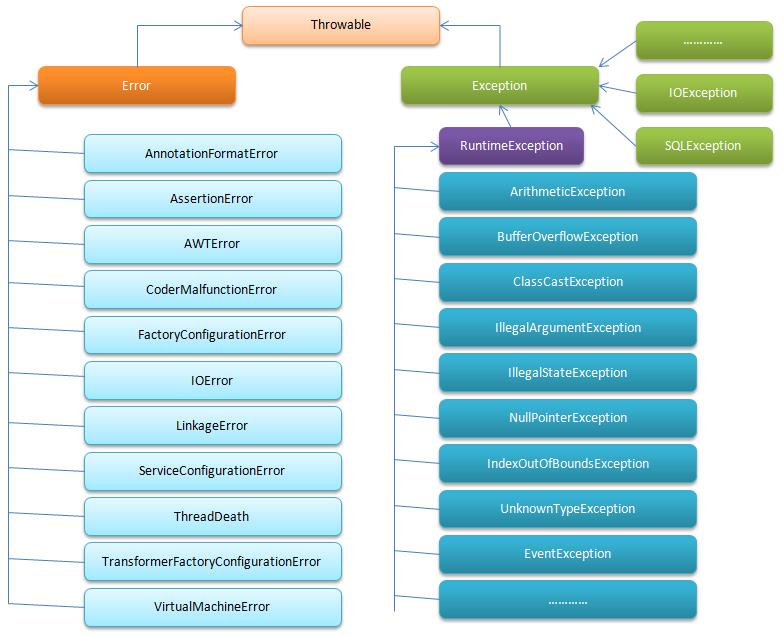Java异常之checked与unchecked
Posted
tags:
篇首语:本文由小常识网(cha138.com)小编为大家整理,主要介绍了Java异常之checked与unchecked相关的知识,希望对你有一定的参考价值。
首先,java的异常分为Error和Exception。这两类都是接口Throwable的子类。Error及Exception及其子类之间的关系,大致可以用下图简述。

注意事项:
1。 Error仅在java的虚拟机中发生,用户无需在程序中捕捉或者抛出Error。
2。 Exception分为一般的Exception和RuntimeException两类。这里有点让人觉得别扭的是RuntimeException(Unchecked)继承于Exception(Checked)的父类。
PS: checked与unchecked的概念理解:
checked: 一般是指程序不能直接控制的外界情况,是指在编译的时候就需要检查的一类exception,用户程序中必须采用try catch机制处理或者通过throws交由调用者来处理。这类异常,主要指除了Error以及RuntimeException及其子类之外的异常。
unchecked:是指那些不需要在编译的时候就要处理的一类异常。在java体系里,所有的Error以及RuntimeException及其子类都是unchecked异常。再形象直白的理解为不需要try catch等机制处理的异常,可以认为是unchecked的异常。
checked与unchecked在throwable的继承关系中体现为下图:
+-----------+
| Throwable |
+-----------+
/ / +-------+ +-----------+
| Error | | Exception |
+-------+ +-----------+
/ | \ / | \ \________/ \______/ +------------------+
unchecked checked | RuntimeException |
+------------------+
/ | | \_________________/
unchecked
下面列举例子说明上面的注意事项2中提到的比较别扭的地方:
首先定义一个基本的异常类GenericException,继承于Exception。
1 package check_unchecked_exceptions; 2 3 public class GenericException extends Exception{ 4 5 /** 6 * 7 */ 8 private static final long serialVersionUID = 2778045265121433720L; 9 10 public GenericException(){ 11 12 } 13 14 public GenericException(String msg){ 15 super(msg); 16 } 17 }
下面定义一个测试类VerifyException。
1 package check_unchecked_exceptions; 2 3 public class VerifyException { 4 5 public void first() throws GenericException { 6 throw new GenericException("checked exception"); 7 } 8 9 public void second(String msg){ 10 if(msg == null){ 11 throw new NullPointerException("unchecked exception"); 12 } 13 } 14 15 public void third() throws GenericException{ 16 first(); 17 } 18 19 public static void main(String[] args) { 20 VerifyException ve = new VerifyException(); 21 22 try { 23 ve.first(); 24 } catch (GenericException e) { 25 e.printStackTrace(); 26 } 27 28 ve.second(null); 29 } 30 31 }
运行后,在eclipse的控制台上得到下面的信息:
1 check_unchecked_exceptions.GenericException: checked exception 2 at check_unchecked_exceptions.VerifyException.first(VerifyException.java:6) 3 at check_unchecked_exceptions.VerifyException.main(VerifyException.java:23) 4 Exception in thread "main" java.lang.NullPointerException: unchecked exception 5 at check_unchecked_exceptions.VerifyException.second(VerifyException.java:11) 6 at check_unchecked_exceptions.VerifyException.main(VerifyException.java:29)
上面的例子,结合checked以及unchecked的概念,可以看出Exception这个父类是checked类型,但是其子类RuntimeException (子类NullPointerException)却是unchecked的。
本博文描述的checked与unchecked概念很基础,但是大家不一定都明白。。。
以上是关于Java异常之checked与unchecked的主要内容,如果未能解决你的问题,请参考以下文章